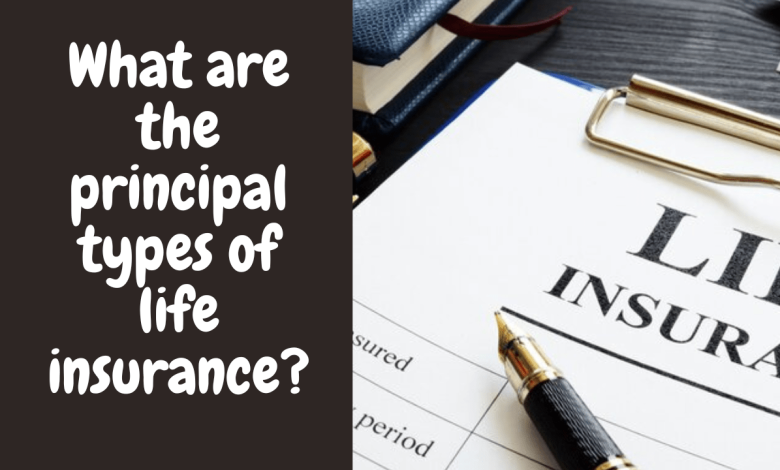
What Are The Principal Types of Life Insurance?
Life insurance is an essential financial tool that provides protection and financial security for individuals and their families. It serves as a safety net, ensuring that loved ones are financially supported in the event of the policyholder’s death. There are various types of life insurance available in the market, each offering different features and benefits. In this article, we will explore the principal types of life insurance: term life insurance and permanent life insurance.
What is Term Life Insurance?
Term life insurance is a type of life insurance coverage that provides protection for a specified period, known as the “term.” It offers a death benefit to the beneficiaries if the insured individual passes away during the term of the policy. Term life insurance does not accumulate cash value and is designed to provide pure protection.
How Term Life Coverage Works

Term life insurance policies are relatively straightforward. Policyholders pay regular premiums, usually on a monthly or annual basis, for the duration of the term. If the insured person dies during the term, the policy pays out a death benefit to the beneficiaries named by the policyholder. The death benefit is usually a lump sum payment and is typically income tax-free.
2.1 Level Term
Level term life insurance is the most common type of term life coverage. With level term, the death benefit remains the same throughout the duration of the policy. Types of Life Insurance For example, a policyholder might purchase a 20-year level term policy with a death benefit of $500,000. If the insured individual passes away within those 20 years, the beneficiaries will receive the $500,000 death benefit.
2.2 Decreasing Term
In contrast to level term insurance, decreasing term life insurance offers a death benefit that gradually decreases over time. This type of policy is often chosen to cover specific financial obligations that decrease over time, such as a mortgage or other debts. The premium payments for decreasing term policies usually remain level, but the death benefit reduces annually. Decreasing term policies are typically more affordable than level term policies.
What is Permanent or Whole Life Insurance?

Permanent life insurance, also known as whole life insurance, is a type of coverage that provides lifelong protection. Unlike term life insurance, permanent life insurance does not have a fixed term and remains in force as long as the policyholder continues to pay the premiums.
What Are The Principal Types of Life Insurance?
3.1 How Does “Cash Value” Work?
One of the key features of permanent life insurance is the accumulation of cash value over time. Part of the premium paid by the policyholder goes towards the cash value component, Types of Life Insurance which grows on a tax-deferred basis. The cash value can be accessed by the policyholder through loans or withdrawals, offering a degree of flexibility and potential for additional financial resources during the insured person’s lifetime.
3.2 Types of Permanent Life Insurance
There are different types of permanent life insurance, including whole life, universal life, and variable life insurance.
- Whole life insurance: This is the most traditional form of permanent life insurance. It provides a guaranteed death benefit, fixed premiums, and a cash value component that grows at a predetermined rate. Whole life insurance offers stability and lifelong coverage.
- Universal life insurance: Universal life insurance provides flexibility in premium payments and death benefit amounts. Policyholders can adjust the death benefit and premium payments within certain limits, offering greater customization. The cash value grows based on a combination of the premium payments and the interest credited to the policy.
- Variable life insurance: Variable life insurance allows policyholders to allocate their premiums among a variety of investment options, such as stocks, bonds, and mutual funds. The cash value of the policy fluctuates based on the performance of these investment options. Variable life insurance offers potential for higher returns but also carries investment risk.
Read About Best Term Life Insurance Companies
Term Life or Permanent Life: Which is Right for Me?
Choosing between term life insurance and permanent life insurance depends on individual circumstances and financial goals. Here are some factors to consider:
- Coverage duration: Term life insurance is suitable for individuals who need coverage for a specific period, such as the duration of a mortgage or until children are financially independent. Permanent life insurance is appropriate for lifelong protection.
- Affordability: Term life insurance typically offers lower premiums, making it more affordable for those on a tight budget. Permanent life insurance premiums are higher but provide lifelong coverage and a cash value component.
- Financial goals: If building cash value is a priority or if there is a need for flexibility in premium payments and death benefit amounts, permanent life insurance may be more suitable. If pure protection and affordability are the primary concerns, term life insurance is a better choice.
In conclusion, term life insurance and permanent life insurance are the principal types of life insurance available. Term life offers coverage for a specified term and is affordable, while permanent life provides lifelong protection and a cash value component. Types of Life Insurance Assessing your needs, financial goals, and budget will help determine which type of life insurance is right for you and your loved ones. Consulting with a financial advisor or insurance professional can provide valuable guidance in making this important decision.



